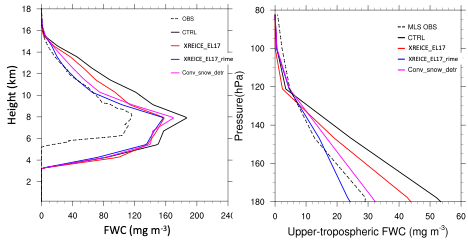Evaluating and improving convective microphysics parameterization in global climate models
Submitter
Fu, Qiang — University of Washington
Area of Research
General Circulation and Single Column Models/Parameterizations
Journal Reference
Lin L, Q FU, X Liu, Y Shan, S Giangrande, G Elsaesser, K Yang, and D Wang. 2021. "Improved convective ice microphysics parameterization in the NCAR CAM model." Journal of Geophysical Research: Atmospheres, 126(9), e2020JD034157, 10.1029/2020JD034157.
Science

Figure 1. Vertical profiles of total frozen water content (FWC, the sum of simulated convective and large-scale cloud solid-phase hydrometeor masses) during the TWP-ICE active monsoon period (19-25 January 2006) in the troposphere (left) and upper-troposphere (UT) (right) from the NCAR CAM5.3 with the convective microphysics scheme (Song and Zhang 2011) (SZ2011). CTRL is the CAM5.3 with the original SZ2011 convective microphysics, XREICE_EL17 uses new terminal velocity parameterizations for convective cloud ice and snow, XREICE_EL17_rime further adds graupel microphysics, and Conv_snow_detr allows convective snow to detrain. From journal.
Convection parameterization remains at the core of large-scale atmospheric modeling. However, cloud microphysics in most convection schemes is often ignored or oversimplified. Partitioning deep convective cloud condensates into components that sediment and detrain, which is important for anvil cloud properties, is sensitive to cloud hydrometeor sedimentation as well as convective updraft vertical velocity. In this study, we evaluate and improve a convective microphysics scheme in the National Center for Atmospheric Research Community Atmosphere Model version 5.3 (CAM5.3).
Impact
The CAM5.3 model with the SZ2011 convective microphysics scheme (Song and Zhang 2011) overestimates the ice amount (by more than 100% in the upper troposphere), which is largely attributed to the underestimation of convective ice particle sedimentation, by comparing with observations from the U.S. Department of Energy Tropical Warm Pool–International Cloud Experiment (TWP-ICE) field campaign. To address this issue, we improve the SZ2011 convective microphysics by (1) considering the sedimentation for cloud ice crystals that do not fall in the original scheme, (2) applying a new terminal velocity parameterization that depends on the environmental conditions for convective snow, (3) adding a new hydrometeor category, “rimed ice”, to the SZ2011 four-class (cloud liquid, cloud ice, rain, and snow) scheme, and (4) allowing convective clouds to detrain snow particles into stratiform clouds. With these improvements, the vertical distribution of ice amount is much improved in the mid- and upper-troposphere when compared with observations. Comparison with observed convective updrafts reveals that the current bulk convection scheme fails to reproduce the observed updraft magnitude and occurrence frequency, suggesting spectral distributions may be required to simulate the subgrid updraft heterogeneity.
Summary
This study implements four improvements to the SZ2011 convective microphysical parameterization in CAM5.3. They include (1) incorporation of cloud ice particle fall velocities, (2) replacement of the snow terminal velocity formulation with a physically based parameterization for convective snow, (3) addition of a rimed ice hydrometeor category to the existing four-class (cloud liquid, cloud ice, rain, and snow) scheme, and (4) enabling convective snow particles to be detrained. This work improves the physical basis for the removal of cloud condensates in a convective microphysics scheme and complements the work that includes rimed ice hydrometeors in a stratiform microphysics scheme (Gettelman et al. 2019).
Keep up with the Atmospheric Observer
Updates on ARM news, events, and opportunities delivered to your inbox
ARM User Profile
ARM welcomes users from all institutions and nations. A free ARM user account is needed to access ARM data.


















